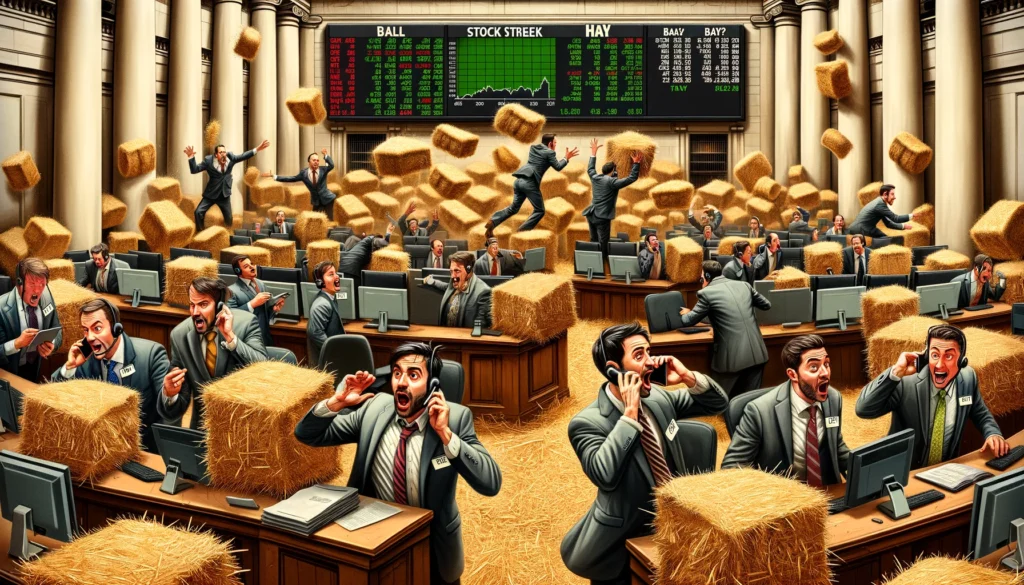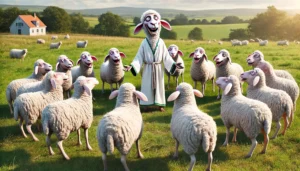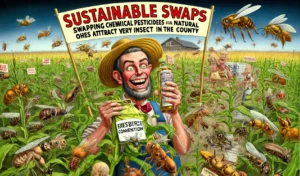
Hay Currency to replace the Dollar A satirical scene of Wall Street traders on the floor of the stock exchange frantically trading bales of hay instead of stocks. The traders are surro.webp.webp
Donald Trump Promises to Declare Hay as the New National Currency: ‘Finally, Something Useful’
Why limit ourselves to printing money when we can just mow it?
Mar-a-Lago, FL – In a stunning turn of events, former President Donald Trump has promised to stabilize the U.S. economy by switching the national currency from the dollar to something more “down to earth”: hay. That’s right, hay. Forget Bitcoin, forget gold—this administration wants to bet everything on bales of grass.
In a statement released from Mar-a-Lago, Trump said, “For years, they’ve been trying to figure out what makes America rich, and it’s been right under our feet the whole time. Hay is everywhere, it’s natural, and it’s the greatest thing anyone’s ever come up with. Finally, something useful!”
As news of the hay currency spread, farmers across the nation rejoiced, finally recognized as the wealthiest citizens in the land. Meanwhile, Wall Street executives, who have spent their lives mastering complex algorithms and derivatives, are scrambling to figure out how to corner the alfalfa market.
Wall Street Bulls? More Like Wall Street Bales
While economists tried to decipher how hay could become the basis of the U.S. financial system, stock traders were spotted lugging bales of the stuff into the New York Stock Exchange. CNBC immediately switched its daily broadcast to highlight the fluctuations of “Big Hay,” reporting live from a farm in Nebraska instead of the usual Wall Street scene.
“I’ve been buying, selling, and trading tech stocks for decades,” said hedge fund manager Carl Wilson, as he dusted off his Brooks Brothers suit, now covered in hay dust. “But alfalfa futures? I didn’t see this coming.”
Congress proposes using hay to fund social programs. Farmers are now the only ones who qualify for these haystacks.
Investors have already begun hedging their bets on whether Bermuda or Timothy grass will be the top-performing assets of the year, with some traders suggesting that hay pellets could be the new coins, and compressed hay blocks might be exchanged like government bonds.
Farmers Hit the Jackpot
Out in rural America, it’s a different story. Farmer Joe Matthews, who’s been producing hay for 40 years, woke up one morning to find that his field of “green gold” had made him richer than Jeff Bezos overnight. “I never thought baling hay would turn me into a millionaire,” he said, shaking his head. “Guess it’s time to start charging five bales for a coffee down at the diner.”
Farmers like Matthews, who previously survived on thin margins and subsidies, now find themselves as key players in the economy. The farming community is buzzing with excitement, as local banks rush to set up vaults that can store the nation’s new wealth—bales of hay.
“We used to think about how many cows we could feed with this stuff,” said farmer Linda Collins from Iowa, “but now I’m thinking about how many Teslas I can buy.”

Banks Branching Out: Hay Loans
Banks, once accustomed to handling paper currency, are now offering “hay loans” to customers looking to purchase real estate, cars, or college degrees. “Instead of credit scores, we’re now evaluating how many acres of hay a person owns,” said one financial analyst. “The days of FICO scores are over. Now it’s all about F-E-E-D scores.”
There are reports of people using hay to barter for everyday necessities, creating entire hay-based microeconomies. Need a new iPhone? That’ll be two bales. Planning a vacation? That’ll cost you a truckload of high-quality alfalfa. Wall Street brokers have even started referring to hedge funds as “haystacks.”
Some tech-savvy entrepreneurs are even creating a new app, “HayPal,” designed to let users send and receive digital hay through their smartphones. You can even “stack” your hay digitally, complete with virtual bales you can move from account to account.
Agricultural Experts Weigh In
While the move has farmers rolling in the hay—quite literally—not everyone is thrilled with the plan. Agricultural economists have expressed concerns about the volatility of the hay market. “Hay is subject to weather, droughts, and pest infestations,” warned Dr. Emma Fields, a professor of agricultural economics. “What happens if there’s a bad harvest? Are we going to have a hay recession?”
In response to these concerns, Trump assured Americans that he’s ready to address any hay-based downturns. “We’ve got plenty of hay—so much hay, you won’t believe it. And if we run out, we’ll just grow more. Simple. I’m a genius.”
The International Hay Standard
Not to be outdone, other countries are beginning to consider their own agricultural products as currency. Canada is exploring a maple syrup-backed dollar, while France is considering switching its entire financial system to a wine-based economy. Analysts believe that Trump’s hay-based currency might force global economic powers to rethink their entire monetary structures.
Meanwhile, the United Nations is reportedly preparing a global summit to discuss the implications of an international hay standard, wherein hay could become the universal trade medium. The IMF has already released a statement calling it “the most ambitious agricultural monetary policy since the invention of livestock.”
Critics Say It’s Full of Straw
Of course, not everyone is convinced that hay is the answer to America’s economic problems. Critics have pointed out that hay has no intrinsic value beyond its use as animal feed and bedding. “This is absolutely ridiculous,” said Senator Bernie Sanders in a recent interview. “We need real solutions, not… whatever this is. Hay? Are you kidding me?”
Even economists like Paul Krugman have weighed in, calling the hay standard “a policy that only makes sense if you’ve spent too much time watching cows.”
Farmers’ New Problems: Hay Theft on the Rise
As the value of hay skyrockets, so do the risks. Reports of hay theft have increased across the country, with farmers forced to install high-tech security systems to protect their newfound wealth. In Texas, one farmer resorted to hiring a private militia to guard his haystacks, while others have begun investing in underground storage bunkers for their premium bales.
“I never thought I’d have to worry about someone stealing hay,” said farmer Tom Johnson, who recently lost ten bales in a midnight raid. “But here we are, living in a world where hay is more valuable than gold.”

A Hay-Based Future?
As the country transitions into its hay-based economy, one question remains: is this sustainable? While hay is a renewable resource, the logistics of using it as currency are already proving difficult. Citizens have been seen dragging bales to grocery stores, only to find they can’t fit them through the checkout lanes. Hay-based ATMs are reportedly in the works, but for now, the only viable method of hay transfer seems to be trading directly from farm to hand.
Still, Trump remains optimistic. “Hay has been the backbone of America for centuries,” he declared. “Now it’s time for hay to take its rightful place as our most valuable asset. We’re going to make America hay-rich again. Believe me.”
In the meantime, Americans are left wondering: how exactly does one deposit hay in a bank account? Will wallets be replaced by miniature baling machines? And what happens when the cows start eyeing your savings?
Conclusion: The Grass is Always Greener
As the U.S. embraces the hay standard, one thing is clear: in a world where farming byproducts are king, the future of wealth is surprisingly… itchy. Wall Street may never be the same, and farmers are finally cashing in on their once humble, grassy fortunes. So, next time you pass a bale of hay, don’t scoff—you might just be looking at the new cornerstone of the American economy.
Disclaimer: This satirical article is purely fictional and should not be taken as financial advice, unless you’ve got a secret stash of hay and a strong back. Any resemblance to real policies is purely coincidental, and any hay-based financial plans are entirely the result of collaboration between a farmer and an AI, neither of whom are qualified economists.
15 Humorous Observations
Hay Nation – Why limit ourselves to printing money when we can just mow it?
Forget Banks, Head to the Barn – Citizens now rush to barns for financial security, with a strong fence becoming the best form of bank vault.
Alfalfa Futures: The New Crypto – It’s like Bitcoin, but scratchier.
Buy Now, Pay Later (in Hay) – Layaway plans are back, except this time, it’s 50 bales upfront and the rest over three harvests.
Hay Bails (Pun Intended) – Banks are offering hay bails as emergency funds, but good luck getting them through the drive-thru teller window.
Golden Bales – Farmers joke about “golden bales,” though they can’t decide if that’s literal or metaphorical wealth.
Insider Trading of the Century – Farmers are hoarding hay in their barns and whispering about ‘inside information’ on Bermuda grass.
Tractor Trailers as Brinks Trucks – Farmers escort their hay across state lines in tractor trailers, protected like they’re hauling diamonds.
Hay-Powered Stimulus Package – Congress proposes using hay to fund social programs. Farmers are now the only ones who qualify for these haystacks.
International Hay Markets – Rumor has it that countries like Russia and China are developing “super hay” for global domination.
Hay-as-Coin: Pocket Full of Scratch – People aren’t using wallets anymore; they’re carrying fistfuls of hay around.
Go Green (and Gold) – Environmentalists are cheering for hay-based currency—finally, an economy powered by something sustainable!
Cows on Strike – Cows are filing grievances, protesting the fact that their food source is now America’s reserve currency.
Fortune 500? More Like Fertile 500 – Corporations are merging with farms to gain control over hay reserves. It’s agriculture’s biggest power grab.
The Rise of Hay Crime – Armed robberies now involve gangs breaking into barns at night. Straw-covered crime scenes are on the rise.
Originally Published at FarmerCowboy.com
2024-09-10 10:25:03
Karl Hoffman is a distinguished agriculturalist with over four decades of experience in sustainable farming practices. He holds a Ph.D. in Agronomy from Cornell University and has made significant contributions as a professor at Iowa State University. Hoffman’s groundbreaking research on integrated pest management and soil health has revolutionized modern agriculture. As a respected farm journalist, his column “Field Notes with Karl Hoffman” and his blog “The Modern Farmer” provide insightful, practical advice to a global audience. Hoffman’s work with the USDA and the United Nations FAO has enhanced food security worldwide. His awards include the USDA’s Distinguished Service Award and the World Food Prize, reflecting his profound impact on agriculture and sustainability.



